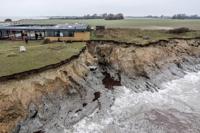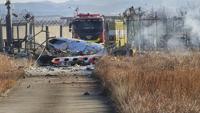DENVER (AP) — The case involves almost everything a victim of sexual harassment would be desperate to avoid.
Multiple requests for follow-up interviews about a traumatizing episode. Bickering over legal fees. Documents with dense legalese and no conclusive answers about the outcome of the three-year-long case.
“At the end of the day, they didn’t even investigate,” the female curler said of her 2020 complaint about sexual harassment at her Colorado curling club filed with the U.S. Center for SafeSport.
to create accountability in the aftermath of sex-abuse scandals in Olympic sports , the SafeSport center’s mandate covers not only the elite facilities molding the nation’s top athletes but also grassroots clubs like the one where the woman trained, which form the backbone of the Olympic system.
The woman’s case, which she shared with The Associated Press on condition she and her sports facility not be named to protect her privacy, was one of five examined by the AP that exposed deep flaws in an overwhelmed agency criticized by athletes, Olympic leaders and investigators with Washington connections.
“What came out of it was feeling that SafeSport is woefully under-equipped for their mission,” said rugby referee Gray Montrose of her own 2021 complaint that she was groped by another referee while driving him to a college tournament in Virginia.
The male referee was given six-months probation, but after Montrose expressed concern about his return to the sport, the center turned around and opened a case against her.
Because of outcomes like this, athletes are often reluctant to criticize SafeSport for “fear of retaliation from the center itself if you have too strong of an opinion,” said Steve McNally, executive director of USA Taekwondo.
Max Cobb, the former president of US Biathlon, said the problems go deeper..
“Too often, the investigations take months or years to begin, and in the end are too slow to be effective within the real-life timeframe in which our athletes and sports happen,” Cobb said.
A charged with investigating the U.S. Olympic system has received numerous complaints about SafeSport. “Over and over again, we’re hearing that athlete safety and the SafeSport process must be a top priority,” said Han Xiao, a retired table tennis player who co-chairs the committee.
The Denver-based center has about 1,000 open cases, a quarter of which are more than a year old, SafeSport spokesman Dan Hill said. With only about 60 full-time investigators it gets around 150 new complaints each week.
According to the center’s 2022 annual report, less than 15% of the 12,751 cases it investigated from March 2017 through 2022 ended with a formal resolution. Another nearly 38% were “administratively closed,” meaning SafeSport made no findings and imposed no sanctions. The agency declined to pursue virtually all the rest, saying they fell outside its sexual misconduct mandate.
“We have come a long way but we also get complaints and we also get feedback,” SafeSport CEO Ju’Riese Colon told the AP. “There’s a lot of work for us to do, but all things considered. I think the organization is doing quite well.”
In the wake of the Nassar abuse case, Congress held hearings and authorized studies leading to legislation creating SafeSport. The idea was to form an independent agency, much like the successful U.S. Anti-Doping Agency, to decide cases without interference from the entities it oversees.
But while the government provides more than half of the anti-doping agency’s $28.5 million budget, , with the rest of its $23 million budget coming from — the U.S. Olympic and Paralympic Committee and the 50-plus sports organizations it oversees.
Critics say there’s no way SafeSport can be effective if most of its funding comes from those it polices.
“Going to SafeSport is like your local diocese saying ’Hey, got a problem with a local priest? Call us,’” said attorney Jon Little, who represented USA Badminton in a long-running case involving a teen athlete who, in 2012, accused a coach of forcing her to have sex.
Among the conclusions drawn by former U.S. attorney general Sally Yates was that SafeSport, which covers nearly 11 million athletes, was overwhelmed. .
Colon defended SafeSport’s broad mandate.
“If the center were to only focus on elite athletes, that would leave around 10 million people in a place where they had no recourse,” she said of the vast number of grassroots athletes.
The five cases the AP examined illustrate how the center’s system has led to an overload of work for a staff that often gave contradictory, confusing and incomplete information to complainants.
The curler’s case involved allegations that a club worker had harassed her in 2017 and 2018, including sending pornographic photos and videos to her cellphone.
SafeSport sent the man a “letter of admonishment,” and though he stopped working at the club, he continued there as a volunteer. The woman again reached out to SafeSport and was urged to contact USA Curling, the Olympic committee and SafeSport itself.
The woman took her case to the Olympic committee’s head of athlete safety, Nicole Deal, who filed her own complaint against the curling club for failing to report the harassment allegations to SafeSport.
That led to multiple SafeSport interview requests. The woman refused, saying she would not repeat the draining hours of questioning she underwent with her first complaint. The woman was never informed about the outcome of Deal's complaint, though she was billed nearly $4,000 in unexpected legal fees.
SafeSport’s handling of the other cases the AP examined, in , , and , were filled with contradictions and confusion that led to a lack of trust in the center from the athletes alleging abuse.
The USA Badminton case involved tense exchanges between SafeSport Vice President Bobby Click and Little, who advocated taking sexual abuse cases to police before going to the center.
“The bottom line is, you should never call SafeSport, you should call the police,” Little said. “The reason I say that is, it’s the law.”
While the center tries to get a grasp on its massive mission, the stakes involved are hard to miss.
A by the global advocacy group, World Players, found 13% of 297 athletes surveyed worldwide had reported sexual abuse as a child in sports.
Cobb gave credit to SafeSport for the job it does educating athletes, coaches and administrators about how to keep sports safe.
But, he said, SafeSport needs a more collaborative approach “that brings athletes and their families together” with sports leaders and the center to set policy.
“It’s time for a fundamental reset.”








































